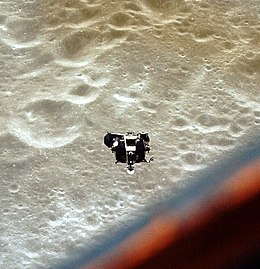 Apollo 10's Lunar Module, Snoopy, approaches the Command and Service Module Charlie Brown for redocking | |
| Mission type | Crewed lunar orbital CSM/LM flight (F) |
|---|---|
| Operator | NASA |
| COSPAR ID |
|
| SATCAT no. |
|
| Mission duration | 8 days, 3 minutes, 23 seconds |
| Spacecraft properties | |
| Spacecraft |
|
| Manufacturer |
|
| Launch mass | 42,775 kg[2] |
| Landing mass | 4,945 kilograms (10,901 lb) |
| Crew | |
| Crew size | 3 |
| Members | |
| Callsign |
|
| Start of mission | |
| Launch date | May 18, 1969, 16:49:00 UTC[3] |
| Rocket | Saturn V SA-505 |
| Launch site | Kennedy LC-39B |
| End of mission | |
| Recovered by | USS Princeton |
| Landing date | May 26, 1969, 16:52:23 UTC |
| Landing site | 15°2′S 164°39′W / 15.033°S 164.650°W |
| Orbital parameters | |
| Reference system | Selenocentric |
| Periselene altitude | 109.6 kilometers (59.2 nmi) |
| Aposelene altitude | 113.0 kilometers (61.0 nmi) |
| Inclination | 1.2 degrees |
| Period | 2 hours |
| Lunar orbiter | |
| Spacecraft component | Command and service module |
| Orbital insertion | May 21, 1969, 20:44:54 UTC |
| Orbital departure | May 24, 1969, 10:25:38 UTC |
| Orbits | 31 |
| Lunar orbiter | |
| Spacecraft component | Lunar Module |
| Orbits | 4 (while solo) |
| Orbital parameters | |
| Periselene altitude | 14.4 kilometers (7.8 nmi) |
| Docking with LM | |
| Docking date | May 18, 1969, 20:06:36 UTC |
| Undocking date | May 22, 1969, 19:00:57 UTC |
| Docking with LM Ascent Stage | |
| Docking date | May 23, 1969, 03:11:02 UTC |
| Undocking date | May 23, 1969, 05:13:36 UTC |

 Left to right: Cernan, Stafford, Young | |
Apollo 10 (May 18–26, 1969) was the fourth human spaceflight in the United States' Apollo program and the second to orbit the Moon. NASA, the mission's operator, described it as a "dress rehearsal" for the first Moon landing (Apollo 11, two months later[4]). It was designated an "F" mission, intended to test all spacecraft components and procedures short of actual descent and landing.
After the spacecraft reached lunar orbit, astronaut John Young remained in the Command and Service Module (CSM) while astronauts Thomas Stafford and Gene Cernan flew the Apollo Lunar Module (LM) to within 14.4 kilometers (7.8 nmi) of the lunar surface, the point at which powered descent for landing would begin on a landing mission. After four orbits they rejoined Young in the CSM and, after the CSM completed its 31st orbit of the Moon, they returned safely to Earth.
While NASA had considered attempting the first crewed lunar landing on Apollo 10, mission planners ultimately decided that it would be prudent to have a practice flight to hone the procedures and techniques. The crew encountered some problems during the flight: pogo oscillations during the launch phase and a brief, uncontrolled tumble of the LM ascent stage in lunar orbit during its solo flight. However, the mission accomplished its major objectives. Stafford and Cernan observed and photographed Apollo 11's planned landing site in the Sea of Tranquility. Apollo 10 spent 61 hours and 37 minutes orbiting the Moon, for about eight hours of which Stafford and Cernan flew the LM apart from Young in the CSM, and about eight days total in space. Additionally, Apollo 10 set the record for the highest speed attained by a crewed vehicle: 39,897 km/h (11.08 km/s or 24,791 mph) on May 26, 1969, during the return from the Moon.
The mission's call signs were the names of the Peanuts characters Charlie Brown for the CSM and Snoopy for the LM, who became Apollo 10's semi-official mascots.[5] Peanuts creator Charles Schulz also drew mission-related artwork for NASA.[6]
- ^ "Apollo 10 summary". NASA. Retrieved July 16, 2022.
- ^ "Apollo 10". NASA Space Science Data Coordinated Archive (NSSDCA). Retrieved November 29, 2022.
- ^ Apollo 10, NASA Space Science Data Coordinated Archive (NSSDCA), retrieved November 29, 2022
- ^ Press Kit, p. 1.
- ^ "Replicas of Snoopy and Charlie Brown decorate top of console in MCC". NASA. May 28, 1969. NASA Photo ID: S69-34314. Archived from the original on June 19, 2001. Retrieved June 25, 2013. Photo description available here Archived October 5, 2021, at the Wayback Machine.
- ^ McKinnon, Mika (April 30, 2014). "Snoopy the Astrobeagle, NASA's Mascot for Safety". Gizmodo. Retrieved June 6, 2019.